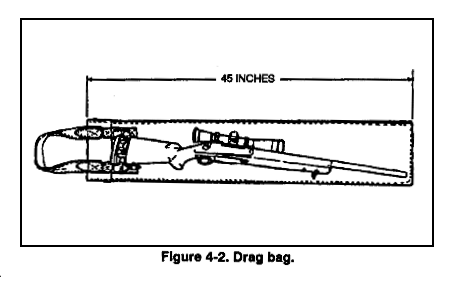
The sniper team may have to use field-expedient camouflage if other means are not available. Instead of camouflage sticks or face paint, the team may use charcoal, walnut stain, mud, or whatever works. The team will not use oil or grease due to the strong odor. Natural vegetation can be attached to the body by boot bands or rubber bands or by cutting holes in the uniform.
a. The sniper team also camouflages its equipment. However, the camouflage must not interfere with or hinder the operation of the equipment.
(1) Rifles. The sniper weapon system and the M16/M203 should also. be camouflaged to break up their outlines. The sniper weapon system can be carried in a "drag bag", which is a rifle case made of canvas and covered with garnish similar to the ghillie suit.

(2) Optics. Optics used by the sniper team must also be camouflaged to breakup the outline and to reduce the possibility of light reflecting off the lenses. Lenses can be covered with mesh-type webbing or nylon hose material.
(3) ALICE pack. If the sniper uses the ALICE pack while wearing the ghillie suit, he must camouflage the pack the same as the suit.
b. The sniper team alters its camouflage to blend in with changes in vegetation and terrain in different geographic areas. Examples of such changes are as follows:
(1) Snow areas. Blending of colors is more effective than texture camouflage in snowy areas. In areas with heavy snow or in wooded areas with trees covered with snow, a full white camouflage suit should be worn. In areas with snow on the ground but not on the trees, white trousers with green and brown tops should be worn.
(2) Desert areas. In sandy desert areas that have little vegetation, the blending of tan and brown colors is important. In these areas, the sniper team must make full use of the terrain and the vegetation that is available to remain unnoticed.
(3) Jungle areas. In jungle areas, textured camouflage, contrasting colors, and natural vegetation must be used.
(4) Urban areas. In urban areas, the sniper team’s camouflage should be a blended color (shades of gray usually work best). Texutred camouflage is not as important in these environments.
c. The sniper team must be camouflage conscious from the time it departs on a mission until it returns. It must constantly use the terrain, vegetation, and shadows to remain undetected. At no other time during the mission will the sniper team have a greater tendency to be careless than during its return to a friendly area. Fatigue and undue haste may override caution and planning. Therefore, the team needs to pay close attention to its camouflage discipline on return from missions.